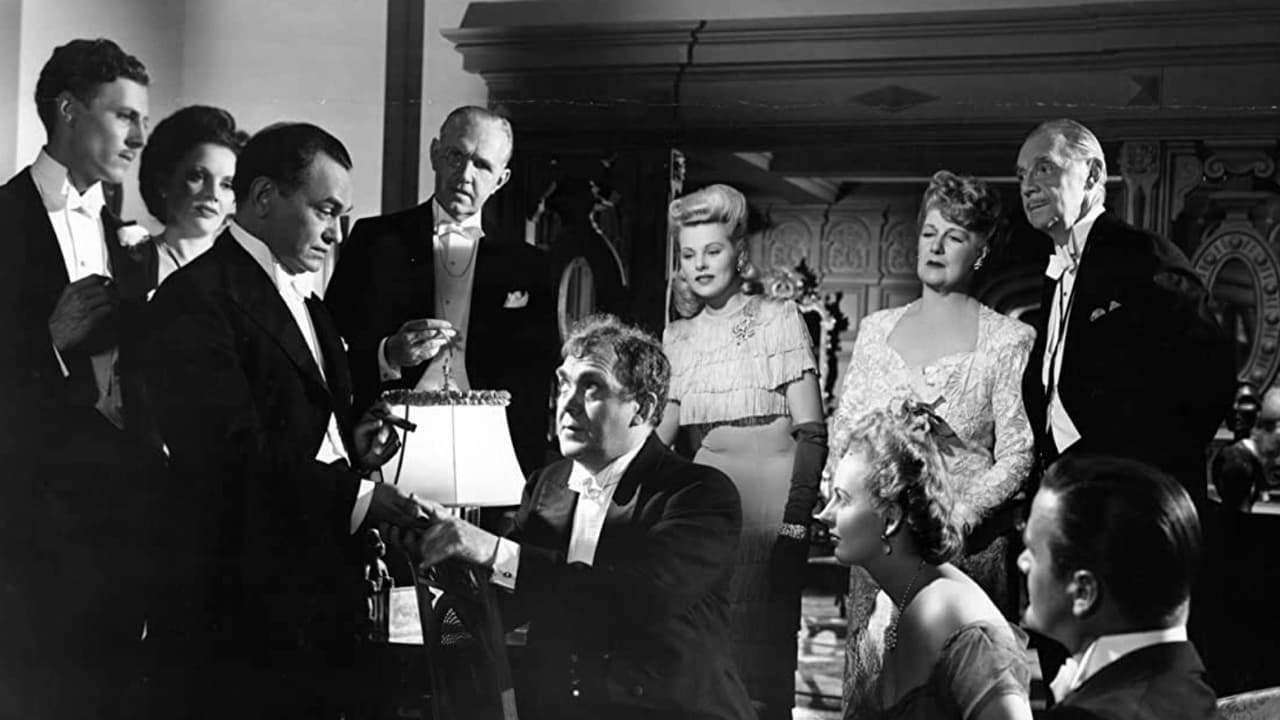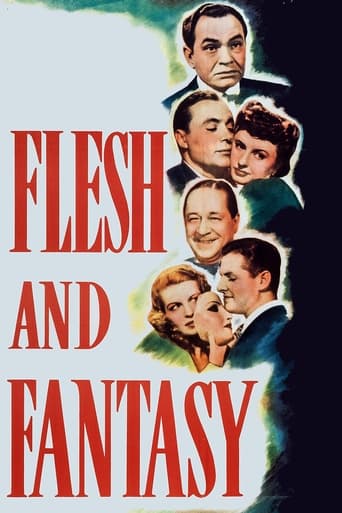

Very well executed
... View MoreGreat Film overall
... View MoreFantastic!
... View MoreIt’s fine. It's literally the definition of a fine movie. You’ve seen it before, you know every beat and outcome before the characters even do. Only question is how much escapism you’re looking for.
... View MoreI finally obtained "Flesh and Fantasy" from someone who taped it off of television. What television, I don't know, since I have never seen it on TCM. And God forbid that Universal should release it on DVD. Given that there are only 11 reviews, it doesn't appear that it's seen too often.Charles Boyer coproduced this film, and one assumes that Julien Duvivier and he were friends, and he got Duvivier to direct. Good choice as he does an excellent job. Also, Duvivier had directed the successful anthology film, Tales of Manhattan.The film begins with a discussion (by Robert Benchley and another man) about the truth of dreams, fortunetelling, superstition and the like. Then three stories, ostensibly from a book, are told. The first is a story by Ellis St. Joseph, starring Robert Cummings and Betty Field, about a bitter, mean, ugly woman who dons a mask on Mardi Gras that makes her look beautiful.The second story, Lord Arthur Savile's Crime, is by Oscar Wilde, about a fortuneteller (Thomas Mitchell) who tells a man (Edward G. Robinson) that he is going to commit a murder. The ending of this story was changed due to the Hays Code.The third story, by Laszlo Vadnay, flows from the second one as The Great Gaspar (Charles Boyer) witnesses something at the end of the previous story. Gaspar is a high wire artist who dreams that he falls, and in his dream, he sees a screaming (Barbara Stanwyck) who is wearing unusual earrings. He then meets her when the circus troupe is sailing abroad.Each story explores some question: can fantasy become reality, can a prediction become a self-fulfilling prophecy, are dreams real warnings? Very entertaining, with good performances and direction, with three good stories.
... View MoreDoakes (Robert Benchley) is read 3 stories to help in his decision as to whether or not to believe in fate or dreams.In the first story, its "Mardi Gras" and everyone is wearing masks and costumes. Henrietta (Betty Field), is depressed as she is ugly and is about to drown herself when a stranger (Edgar Barrier) appears. He leads her to a mask shop and tells her to pick a mask and join the festivities on condition that she return at midnight. She goes out and meets with Michael (Robert Cummings) who she has loved from afar for a considerable time. Wearing her mask, she enjoys a few hours with him before returning to the mask shop at midnight. However, Michael has followed her......In the second story, a palmist (Thomas Mitchell) is predicting events with astonishing accuracy at a soirée at the house of Lady Pamela (May Witty). Marshall (Edward G Robinson) sees that the palmist is not being honest with him and goes to his house to insist that he tells him the truth about what he can see. He warns Marshall that he will kill someone. The rest of the tale is played out with Marshall struggling with his conscience as he picks victims to kill.....In the third story, a tightrope-walker (Charles Boyer) has a dream that during his act he falls from the wire while staring at a woman (Barbara Stanwyck) that he has never met. The dream prompts him to cancel the dangerous part of his act. On his way over to America he meets the woman on the boat and they fall in love. He asks her to attend his next show which she does. What happens....?...........It is well-acted and I liked the first 2 stories in particular. The only dodgy part to the 1st tale is in believing that Henrietta is ugly - she just isn't! In the 2nd tale, Edward G Robinson is very good as he reconciles himself to his fate and delivers some funny lines along the way. There is also good support from the Dean (C Aubrey Smith). The 3rd story develops at a slower pace than the previous two and has an ambiguous ending.....Its a film that you remember once it has finished.
... View MoreJulien Duvivier was not only one of the best Directors who ever came out of France but also one of the most versatile being more than adept in several genres. Try telling that to Hollywood: Having prevailed upon him to remake his masterpiece Un Carnet de bal as Lydia they next got him to follow it with Tales Of Manhattan and then yet another episodic piece Flesh and Fantasy. To dispense with pedantry first of all; it seems that one reviewer mistakenly attributed the second segment to Noel Coward when it was, of course, the work of Oscar Wilde; in correcting the initial reviewer the person who did so claimed erroneously that both Wilde and Coward were English and gay; only 50 per cent of that statement is true; Oscar Wilde was Irish, a native of Dublin, who settled in England. Stuff like this tends to distract from the film which, in this case, is as good as one might suppose with anything to which the name Duvivier is appended. There are three basic segments linked loosely by Robert Benchley anchored in a Gentlemen's Club more than likely located in Pall Mall. The first segment reunites Robert Cummings and Betty Field who had starred the year before in a similar multi-storied adaptation King's Row; Field plays the Ugly Duckling who convinces Cummings via a little sleight-of-hand that she is a Swan. The second segment finds Edward G. Robinson initially bemused then increasingly terrified by a palmist's prediction that he will commit murder whilst the final segment sees tightrope walker Charles Boyer dreaming of falling from the high wire watched by a Barbara Stanwyck he has yet to meet. None of the segments is especially original but the combination of stylish direction and fine acting lifts it out of the rut.
... View MoreThe inevitability of Fate and the mysterious movements of Destiny control our FLESH AND FANTASY.Director Julien Duvivier, in a follow-up to his previous TALES OF MANHATTAN (1942), crafted this new & intriguing sequential film. The emphasis, this time, is on the supernatural and precognition. In spite of the film's homilies about the ultimate power of personal responsibility, the movie is in reality about nothing more than providing some suspenseful entertainment for its audience.The three sequences are tied together by Robert Benchley, in his famous character of Doakes, who is shown the stories in a book at his men's club in an attempt to help him get over a case of the jitters.SEQUENCE ONE A bitter, unattractive seamstress (Betty Field) hopes a Mardi Gras mask will help her attract the affections of a young student (Robert Cummings). Edgar Barrier appears as the mysterious mask maker. Movie mavens will spot Marjorie Lord as a desperate client and Peter Lawford as an inquisitive Pierrot, both unbilled.The most intriguing moments in this sequence happens in the first few seconds, when demons are shown pulling a corpse out of the water, and in the last few, when the viewer sees what is in the mask shop window. Mr. Barrier's voice, honed by years of stage and radio experience, is put to good effect.SEQUENCE TWO A London lawyer (Edward G. Robinson) is told by a celebrated palmist (Thomas Mitchell) that he will commit a murder. Anna Lee appears as Robinson's fiancée; Dame May Whitty as her gossipy godmother. Wonderful Sir C. Aubrey Smith makes the most of his short role as a saintly cleric. Doris Lloyd plays a grieved widow, and Ian Wolfe a librarian, both uncredited.Based on a short story by Oscar Wilde, this is the film's most compelling episode. The acting is especially good, with Robinson topnotch and Mitchell turning in a canny performance. The special effects, in which Robinson discourses with his own reflection, are executed very nicely. Notice the mistake in the credits when they refer to Sir C. Aubrey Smith's character as the Dean of Chichester rather than the Dean of Norwalk.SEQUENCE THREE A circus aerialist (Charles Boyer) has a frightening dream in which he sees a beautiful woman (Barbara Stanwyck)-- and then he meets her. Charles Winninger plays the concerned owner of the circus. Clarence Muse appears unbilled as Boyer's attendant.The story is slightly silly, but the stars make a fine effort and the high wire scenes, using a double, are indeed suspenseful.
... View More